Eco-Friendly Balloons: Investigating Biodegradable Alternatives
When planning a celebration, whether it's a birthday, wedding, or special event like Valentine’s Day, colorful balloons often come to mind as a must-have decoration. Over the years, there has been a growing demand for eco-friendly balloons that claim to be biodegradable and environmentally responsible. These balloons, often made from natural latex or other supposedly sustainable materials, are marketed as a greener alternative to traditional balloons. But are eco-friendly balloons truly possible, or is it just a marketing myth?
In this article, we will unravel the truth about eco-friendly balloons and explore why they don't truly exist. We'll look into the damaging effects of plastic pollution and biodegradable waste in landfills and conclude by advocating for reusable party decorations as a more sustainable choice.

What are Biodegradable Balloons and Can They Go Safely into Your Compost Bin?
Biodegradable balloons are balloons made from materials that can break down naturally over time when exposed to environmental conditions like moisture, heat, and microorganisms. These balloons are typically made from natural materials like latex and certain types of plastics that degrade more readily compared to traditional balloons made from synthetic materials like rubber or Mylar.
While biodegradable balloons can break down faster than their synthetic counterparts, it's important to note that they still require specific conditions to decompose properly. They might not fully degrade in a typical home compost bin because these bins may not provide the ideal conditions for the breakdown process to occur efficiently. Additionally, some composting facilities may not accept biodegradable balloons due to concerns about contaminants or the potential for them to cause issues during the composting process.
It's always best to check with your local waste management authority to see if they have specific guidelines for disposing of biodegradable balloons. In most cases, they may recommend disposing of them in the regular trash to prevent potential harm to wildlife or the environment.
The Landfill Problem
One of the fundamental issues with eco-friendly balloons is their ultimate destination: the landfill. When balloons, whether biodegradable or not, end up in landfills, they contribute to a much bigger problem—methane production. Biodegradable items in landfills produce methane gas as they break down anaerobically. Consequently, it results in a greenhouse gas that significantly contributes to climate change. In essence, biodegradable balloons in landfills are not as eco-friendly as they may sound.
Slow Degradation
Biodegradable balloons, made from materials like natural latex, may indeed break down over time, in perfect conditions, but the process can be surprisingly slow and unrealistic. In practice, it can take years for these balloons to degrade fully. In the meantime, they pose a risk to wildlife and the environment. The slow degradations of eco-friendly balloons means they can persist in the ecosystem, causing harm even after the celebration has ended.
The Damaging Effects of Plastic Pollution
To understand why eco-friendly balloons fall short of their green claims, it's essential to consider the broader issue of plastic pollution. Traditional balloons made from latex or plastic contribute significantly to this problem, but even biodegradable alternatives do not escape blame since they do contain plastic matter.
Microplastic Generation
As balloons, biodegradable or not, degrade over time, they break down into smaller fragments, eventually becoming microplastics. These tiny plastic particles can infiltrate the environment, contaminating soil and water sources. Microplastics pose a severe threat to aquatic life and can even find their way into the human food chain.
Wildlife Hazards
Both traditional and eco-friendly balloons are known to pose dangers to wildlife. Animals may ingest balloon fragments, leading to ingestion-related injuries or fatalities. Additionally, balloon strings and ribbons can entangle and harm birds and marine creatures. This makes it clear that the environmental impact of balloons extends far beyond their degradation or decompostation rates.
The Myth of Eco-Friendly Balloons
"Eco-friendly balloons" have become a buzzword in recent years, offering the promise of environmentally responsible party decorations. Yet, the truth behind these labels is far less green than we'd like to believe. As we previously determined, even when marketed as biodegradable, eco-friendly balloons encounter substantial obstacles when it comes to fulfilling their environmental pledges. The fundamental issue lies in their most-often destination: the landfill. Balloons, whether labeled eco-friendly or not, contribute to methane production in landfills, a potent greenhouse gas. Furthermore, the slow decomposition of these balloons means they persist in the environment, posing threats to wildlife. In reality, the concept of eco-friendly balloons is a myth, and a closer look reveals that their impact on the environment is more significant than we might have imagined.
The Sustainability Challenge
With the environmental drawbacks of balloons, it's clear that finding truly eco-friendly options is a challenge. However, there are sustainable alternatives to consider when decorating for your next celebration.
Environmentally Responsible Alternatives
Instead of relying on balloons, you can opt for reusable party decorations that not only reduce waste but also offer a unique and personal touch to your event. Consider options like:
- Nature-Inspired Decor: Forage for items in nature, such as pinecones, leaves, and branches, to create charming and eco-friendly decorations.
- DIY Wildflower Seed Bombs: Craft seed bombs using native wildflower seeds, clay, and compost to beautify your surroundings. Display them in decorative bowls or baskets as centerpieces on tables or arrange them in clusters around the venue. Consider giving out the seed bombs as party favors to your guests. Package them in eco-friendly bags or boxes with instructions for planting.
- Solar-Powered Luminaries: Illuminate your event with reusable luminaries powered by solar lights, saving energy and reducing waste.
- Fabric Banners: Create colorful fabric banners using scraps of fabric or reusable cloth. These banners can be easily hung indoors or outdoors and reused for multiple parties. They add a festive touch and can be customized to match any theme or color scheme.
- Paper Lanterns: Opt for paper lanterns instead of balloons for a whimsical and reusable decoration. You can find paper lanterns in various shapes, sizes, and colors to suit your party theme. They can be stored and reused for future celebrations.
- Origami Creations: Get creative with recycled paper and fold your way to unique origami decorations.
- Garlands: Make garlands using materials like paper, fabric, or even dried flowers. These can be hung across walls, ceilings, or tables to add a decorative element to your party space. Garlands are versatile and can be reused for different occasions.
- Potted Plants: Use potted plants as natural and reusable decorations. Succulents, herbs, or flowering plants can serve as centerpieces or accents throughout the party area. Guests can even take home a plant as a party favor at the end of the event.
- Reusable Tableware: Instead of disposable plates, cups, and utensils, invest in reusable tableware made from materials like bamboo, stainless steel, or durable plastic. These can be washed and reused for future parties, reducing waste and saving money in the long run.
- Chalkboard Signs: Use chalkboard signs or boards to display party messages, directions, or menus. Chalkboard surfaces can be easily wiped clean and reused for different events, making them a versatile and eco-friendly option for party décor.
- DIY Centerpieces: Get creative and make your own centerpieces using reusable materials like glass jars, candles, or seasonal fruits and vegetables. These homemade centerpieces add a personal touch to your party and can be reused or repurposed after the event.
- Fabric Tablecloths: Instead of disposable plastic tablecloths, opt for reusable fabric tablecloths or runners. Choose durable fabrics that can be easily washed and reused for future parties. Fabric tablecloths come in a variety of colors and patterns to suit any theme.
- Kites: Fly kites that can be reused for future celebrations.
- Biodegradable Confetti: Use birdseed, dried flower petals or leaves as your fully biodegradable confetti options, minimizing the impact on the environment.
Making Sustainable Choices
In the quest for eco-friendly decorations, it's essential to acknowledge the limitations of balloons, even those labeled as biodegradable. These supposedly green alternatives can still contribute to environmental issues, such as methane production and plastic pollution, especially when they end up in landfills.
To make sustainable choices for your celebrations, consider reusable party decorations and environmentally responsible alternatives that reduce waste and minimize harm to the environment. By opting for these alternatives, you can enjoy festive decorations while taking a step towards a greener and more eco-conscious future. Balloons may be a symbol of celebration, but choosing sustainability over convenience is a celebration of a different kind-one that benefits the planet we all call home.
Looking for a Recipe? Search here!

Mindful Minutia provides practical tips on managing everyday activities in a more sustainable way. Authored by Tamara Schweitzer for her daughter Emily, all children, and their sustainable tomorrow. Discover more about our author through a candid interview.


Leave a comment
This site is protected by reCAPTCHA and the Google Privacy Policy and Terms of Service apply.